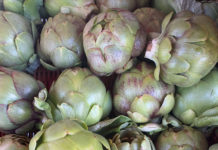As the winter rains continue to fall, and hopefully bring relief to our watershed communities mired in a historic drought, the rainwater will begin to soak into our gardens and fields and run down the streets into our storm drains, which are not linked to the sewer. Storm drains are specifically designed to capture excess stormwater from streets and divert the flows through culverts and drainage channels into creeks, rivers, and eventually the Pacific Ocean. Stormwater drainage systems are not limited to just the drains on our streets; they can also include engineered systems which help reduce flooding, increase groundwater recharge, and improve overall resilience of the ecosystem. These engineered systems are called Low Impact Development (LID).
You may have seen examples of LID around your neighborhood. They are often designed to be subtle and look commonplace but play an important role in protecting our water resources. LID projects include tree boxes, pervious sidewalks, curb extensions, bio retention areas and rain gardens. They all operate under a similar principle of slowing runoff from impervious surfaces such as roadways, sidewalks, roofs, and driveways by diverting the runoff to LIDs which provide catchment areas for the water allowing it to filter through vegetation, soils, sand and gravel to slow the runoff, reduce flooding, and capture the stormwater in reservoirs, creating natural, green spaces. These retention areas can take the forms of rain gardens that capture excess runoff from your roof or tree wells at low points in your garden that increase infiltration. Unfortunately, stormwater runoff contains many pollutants, but there are steps you can take to protect these retention ponds to keep them functioning for years to come. Many of these projects can be easily implemented into your own home, and the Russian River Watershed Association has some fantastic resources found here: (www.rrwatershed.org/resource-library).
Stormwater systems were originally intended to route rainwater quickly off the streets during heavy storms. Unfortunately, these systems can carry pollutants such as pesticides, harmful bacteria, and chemicals from city streets straight into our creeks — of particular concern are used motor oil, pet waste and sharps.
Used oil from a single oil change can pollute up to one million gallons of freshwater. Improper disposal of used oil, which includes oil leaking from cars, contributes significantly to stormwater pollution. The EPA estimates that American households improperly dump approximately 193 million gallons of used oil every year, or roughly the equivalent of 17 industrial oil spills. Properly recycling your used motor oil reduces this pollution threat. When you take your used oil to a certified center for recycling, you are protecting the environment, conserving a valuable resource, and getting paid for it! If you have containers of used oil, you can take them to a certified collection center (CCC). Additionally, many communities have curbside recycling programs that allow you to leave your oil at the curb (if properly packaged). Or you can have your oil changed by a service station that recycles the oil for you. Visit the CalRecycle page for more information.
Like used oil, pet waste is one of the many contributors of stormwater pollution that can degrade water quality. During rainfall, pet waste left on lawns, beaches, trails, and sidewalks washes into storm drains where the waste and the pathogens it contains end up flowing directly into streams where they can harm human health and the environment. It has been estimated that a single gram of dog waste can contain 23 million fecal coliform bacteria, which are known to cause cramps, diarrhea, intestinal illness, and serious kidney disorders in humans. So picking up after your pet is a simple thing you can do to help keep harmful bacteria out of your local waterways!
Another particular concern is needles and other sharp objects left near waterways and in the gutters or on streets. Prescription medicines in our storm drains can have serious effects on the wildlife that inhabit the Russian River, such as disrupting natural reproduction patterns. Sharps left on the streets can endanger those who clean the drains. Any person accidentally stuck or cut must undergo medical testing for exposure to harmful or deadly diseases such as Hepatitis B, Hepatitis C and HIV. Proper disposal of sharps can keep you, your family, your community, and the environment safe. Sharps containers may be obtained from your doctor, hospital, health insurance provider, medical supplier, pharmacist, or online. In some case they can be obtained free of charge. If you are unable to obtain an approved sharps container you may make your own using the following steps: place sharps in an empty hard plastic laundry detergent or bleach bottle, screw the lid shut and secure it with strong tape, and clearly label the bottle “SHARPS” with a permanent marker. After you have collected your sharps in the container you can deposit them at designated pickup points as they should never go in your regular trash. More information can be found here and here on how to properly dispose of sharps in Mendocino and Sonoma Counties.
Storm drains and other LID features are valuable design features for diverting rain flow from impervious surfaces back into the ground and our waterways. Yet these systems are prone to pollution and must be protected with everyone doing their part to reduce their impact.
This article was authored by Michael Harrigan, Environmental Compliance Specialist, Mendocino County Water Agency, on behalf of RRWA. RRWA (www.rrwarshed.org) is an association of local public agencies in the Russian River Watershed that have come together to coordinate regional programs for clean water, habitat restoration, and watershed enhancement.








